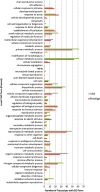Transcriptome analysis of two buffalograss cultivars
- PMID: 24024986
- PMCID: PMC3846939
- DOI: 10.1186/1471-2164-14-613
Transcriptome analysis of two buffalograss cultivars
Abstract
Background: Buffalograss [Buchloë dactyloides (Nutt.) Engel. syn. Bouteloua dactyloides (Nutt.) Columbus] is a United States native turfgrass species that requires less irrigation, fungicides and pesticides compared to more commonly used turfgrass species. In areas where water is limited, interest in this grass species for lawns is increasing. While several buffalograss cultivars have been developed through buffalograss breeding, the timeframe for new cultivar development is long and is limited by a lack of useful genetic resources. Two high throughput next-generation sequencing techniques were used to increase the genomic resources available for buffalograss.
Results: Total RNA was extracted and purified from leaf samples of two buffalograss cultivars. '378' and 'Prestige' cDNA libraries were subjected to high throughput sequencing on the Illumina GA and Roche 454 Titanium FLX sequencing platforms. The 454 platform (3 samples) produced 1,300,885 reads and the Illumina platform (12 samples) generated approximately 332 million reads. The multiple k-mer technique for de novo assembly using Velvet and Oases was applied. A total of 121,288 contigs were assembled that were similar to previously reported Ensembl commelinid sequences. Original Illumina reads were also mapped to the high quality assembly to estimate expression levels of buffalograss transcripts. There were a total of 325 differentially expressed genes between the two buffalograss cultivars. A glycosyl transferase, serine threonine kinase, and nb-arc domain containing transcripts were among those differentially expressed between the two cultivars. These genes have been previously implicated in defense response pathways and may in part explain some of the performance differences between 'Prestige' and '378'.
Conclusions: To date, this is the first high throughput sequencing experiment conducted on buffalograss. In total, 121,288 high quality transcripts were assembled, significantly expanding the limited genetic resources available for buffalograss genetic studies. Additionally, 325 differentially expressed sequences were identified which may contribute to performance or morphological differences between 'Prestige' and '378' buffalograss cultivars.
Figures





Similar articles
-
Transcriptome Profiling of Buffalograss Challenged with the Leaf Spot Pathogen Curvularia inaequalis.Front Plant Sci. 2016 May 25;7:715. doi: 10.3389/fpls.2016.00715. eCollection 2016. Front Plant Sci. 2016. PMID: 27252728 Free PMC article.
-
Molecular characterization of Buffalograss germplasm using sequence-related amplified polymorphism markers.Theor Appl Genet. 2004 Jan;108(2):328-34. doi: 10.1007/s00122-003-1428-4. Epub 2003 Sep 13. Theor Appl Genet. 2004. PMID: 13679978
-
Transcriptional Profiling of Resistant and Susceptible Buffalograsses in Response to Blissus occiduus (Hemiptera: Blissidae) Feeding.J Econ Entomol. 2015 Jun;108(3):1354-62. doi: 10.1093/jee/tov067. Epub 2015 Mar 31. J Econ Entomol. 2015. PMID: 26470264
-
Exploring the switchgrass transcriptome using second-generation sequencing technology.PLoS One. 2012;7(3):e34225. doi: 10.1371/journal.pone.0034225. Epub 2012 Mar 29. PLoS One. 2012. PMID: 22479570 Free PMC article.
-
Understanding ploidy complex and geographic origin of the Buchloe dactyloides genome using cytoplasmic and nuclear marker systems.Theor Appl Genet. 2005 Nov;111(8):1545-52. doi: 10.1007/s00122-005-0083-3. Epub 2005 Nov 10. Theor Appl Genet. 2005. PMID: 16208501
Cited by
-
Characterization of Withania somnifera leaf transcriptome and expression analysis of pathogenesis-related genes during salicylic acid signaling.PLoS One. 2014 Apr 16;9(4):e94803. doi: 10.1371/journal.pone.0094803. eCollection 2014. PLoS One. 2014. PMID: 24739900 Free PMC article.
-
Transcriptome Profiling of Buffalograss Challenged with the Leaf Spot Pathogen Curvularia inaequalis.Front Plant Sci. 2016 May 25;7:715. doi: 10.3389/fpls.2016.00715. eCollection 2016. Front Plant Sci. 2016. PMID: 27252728 Free PMC article.
-
Transcriptomic variation of hepatopancreas reveals the energy metabolism and biological processes associated with molting in Chinese mitten crab, Eriocheir sinensis.Sci Rep. 2015 Sep 15;5:14015. doi: 10.1038/srep14015. Sci Rep. 2015. PMID: 26369734 Free PMC article.
-
Making Plants Break a Sweat: the Structure, Function, and Evolution of Plant Salt Glands.Front Plant Sci. 2017 Mar 28;8:406. doi: 10.3389/fpls.2017.00406. eCollection 2017. Front Plant Sci. 2017. PMID: 28400779 Free PMC article. Review.
-
De Novo Transcriptome Analysis for Kentucky Bluegrass Dwarf Mutants Induced by Space Mutation.PLoS One. 2016 Mar 24;11(3):e0151768. doi: 10.1371/journal.pone.0151768. eCollection 2016. PLoS One. 2016. PMID: 27010560 Free PMC article.
References
-
- Shearman RC, Riordan TP, Johnson PG. In: Warm-season (C4) grasses, agronomy monograph 45. Moser LE, Burson BL, Sollenberger LE, editor. Madison: American Society of Agronomy, Crop Science Society of America, Soil Science Society of America; 2004. Buffalograss; pp. 1003–1026.
-
- Johnson PG, Riordan TP, Arumuganathan K. Ploidy level determinations in buffalograss clones and populations. Crop Sci. 1998;38(2):478–482. doi: 10.2135/cropsci1998.0011183X003800020034x. - DOI
-
- Wu L, Harivandi A. Buffalograss response to cold, shade, and salinity. Calif Turfgrass Cult. 1995;45(1/2):5–7.
-
- Baxendale FP, Heng-Moss TM, Riordan TP. Blissus occiduus barber (Hemiptera: Lygaeidae): a chinch bug pest new to buffalograss turf. J Econ Entomol. 1999;92(5):1172–1176.
-
- Wenger L. Buffalograss, bulletin 321. Manhattan: Kansas Agricultural Experiment Station; 1943.
Publication types
MeSH terms
LinkOut - more resources
Full Text Sources
Other Literature Sources
Miscellaneous

